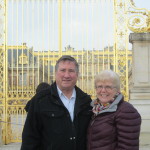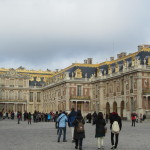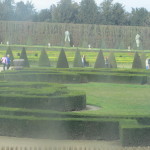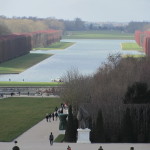Chateau/Estate/Palace de Versailles lies south west of the City of Paris (about 15 Km), a short metro/RER/Train/Bus ride away. Â There are
many ways to get there for most it’s via the RER C5, purchase a zone 4 ticket or simple select Chateau Versailles Rive Gauche from the list of destination at an automated ticket machine. The cost 4.10€ for a one way ticket, you will need two per person, one for the trip out and one for the return.  The RER can be a bit tricky to use, so be sure to check the TV Monitor in the station and make sure you board a train head for Chateau Versailles (Rive Gauche).  When the train enters the station it will have the 4 letter code on the front of the train!  When you
arrive at the Versailles RG Â train station exit to the street and turn right and go one block and then cross the street and head in the direction of the Chateau, you will see it in the distance about a 10 minute walk.
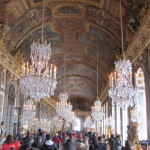
Hall of Mirrors (See video for more details)
When you arrive follow the signs to the ticket office and buy a 1 day passport (18€) which will get you in to both the Chateau and Petit Trianon.
We explored the estate, visiting the Palace, with it’s Hall of Mirrors, King’s Chamber, Â and the Queen’s bedroom, the gardens, with their fountains, statues and giant reflecting pool and the Petit
Trianon, with it grand staircase.
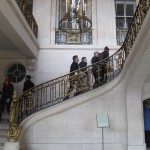
Grand Staircase in the Petit Trianon
Below is a partial history and more information is available on the Palaces web site.
Enjoy a slide show of some of the more interesting photos that we captured during our vista to the Chateau de Versailles in February 2014, it was our third visit one in June  2000, one in October 2011 and this year.  Always something new to see and of course the month provide a whole new perspective on the gardens and architecture.
http://marionjensen.com/2009/02/cory-doctorow.html The Palace
The Château de Versailles, which has been on UNESCO’s World Heritage List for 30 years, is one of the most beautiful achievements of 18th-century French art. The site began as Louis XIII’s hunting lodge before his son Louis XIV transformed and expanded it, moving the court and government of France to Versailles in 1682. Each of the three French kings who lived there until the French Revolution added improvements to make it more beautiful.
The Hall of Mirrors, the King’s Grand Apartments, the Museum of the History of France. The Château de Versailles, the seat of power until 1789, has continued to unfurl its splendour over the course of centuries. At first it was just a humble hunting lodge built by Louis XIII. But Louis XIV chose the site to build the palace we know today, the symbol of royal absolutism and embodiment of classical French art.
In the 1670s Louis XIV built the Grand Apartments of the King and Queen, whose most emblematic achievement is the Hall of Mirrors designed by Mansart, where the king put on his most ostentatious display of royal power in order to impress visitors. The Chapel and Opera were built in the next century under Louis XV.
The château lost its standing as the official seat of power in 1789 but acquired a new role in the 19th century as the Museum of the History of France, which was founded at the behest of Louis-Philippe, who ascended to the throne in 1830. That is when many of the château’s rooms were taken over to house the new collections, which were added to until the early 20th century, tracing milestones in French history.
http://cyberblogue.com/vmware-vsphere-5-1-vconverter-5-0-p2v-windows-2000-server The Gardens
From the central window of the Hall of mirrors the visitor look down on the grand perspective that leads the gaze from the Water Parterre to the horizon. This original perspective, which preceded the reign of Louis XIV, was developed and prolonged by the gardener André Le Nôtre by widening the Royal Path and digging the Grand Canal. This vast perspective stretches from the façade of the Château de Versailles to the railings of the park.
In 1661, Louis XIV commissioned André Le Nôtre with the design and laying out of the gardens of Versailles which, in his view, were just as important as the Château. The works were undertaken at the same time as those for the palace and took forty years to complete. But André Le Nôtre did not work alone: Jean-Baptiste Colbert, Superintendent of the King’s Buildings, directed the project from 1664 to 1683; Charles Le Brun, appointed First Painter of the King in January 1664, produced the drawings for a large number of statues and fountains; and, a little later, the architect Jules Hardouin-Mansart drew up increasingly understated scenic plans and built the Orangerie. Lastly, the King had all the projects submitted to him and wanted the “details of everythingâ€.
The laying out of the gardens required enormous work. Vast amounts of earth had to be shifted to lay out the flower beds, the Orangerie, the fountains and the Canal, where previously only woods, grasslands and marshes were. The earth was transported in wheelbarrows, the trees were conveyed by cart from all the provinces of France and thousands of men, sometimes whole regiments, took part in this vast enterprise.
Since 1992, the gardens have been gradually replanted, and after the devastating storm of December 1999, the work speeded up to such an extent that quite a few sections have already been restored to their original appearance.

